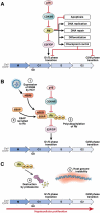Is hepatitis C virus carcinogenic?
- PMID: 22537433
- PMCID: PMC4422399
- DOI: 10.1053/j.gastro.2012.01.045
Is hepatitis C virus carcinogenic?
Abstract
Although infection with hepatitis C virus (HCV) has become a leading cause of hepatocellular carcinoma, the mechanisms by which it results in carcinogenesis remain a subject of debate. Here, we explore the possibility that HCV replication impairs cellular DNA damage responses, thereby promoting instability of the infected host cell genome, and that HCV exerts a direct cancer-promoting effect in addition to eliciting immune-mediated inflammation and apoptosis of hepatocytes contributing to hepatocellular carcinogenesis.
Figures


References
-
- Kiyosawa K, Akahane Y, Nagata A, et al. Hepatocellular carcinoma after non-A, non-B hepatitis. American Journal of Gastroenterology. 1984;79:777–781. - PubMed
-
- El-Serag HB. Hepatocellular carcinoma. N Engl J Med. 2011;365:1118–27. - PubMed
-
- Donato F, Tagger A, Gelatti U, et al. Alcohol and hepatocellular carcinoma: the effect of lifetime intake and hepatitis virus infections in men and women. Am J Epidemiol. 2002;155:323–31. - PubMed
Publication types
MeSH terms
Substances
Grants and funding
LinkOut - more resources
Full Text Sources
Medical

